Pacific Rim, Week 5: Chinese 4
Week 4 of Chinese cuisine! We're all getting more comfortable working the woks. Really, the only rough part is gracefully handling our wok jets. Those suckers get hot!* We've all got a good grasp on our velvet marinades, though (in other words, knowing that every slice of meat should get it, and that it makes a huge difference in texture when doing stir-frys). I'm constantly impressed with my classmates' knife skills.
One of my teammate's plates, clockwise from spring roll: beef lo mein, shrimp chip, orange chicken, ma po tofu, stir-fried shrimp with lobster sauce, curried pineapple rice, Hunan beef
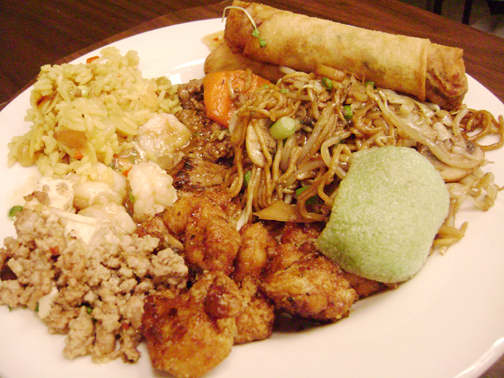
My plate, clockwise from shrimp chips: ma po tofu, curried pineapple rice, spring roll, stir-fried shrimp with lobster sauce, Hunan beef, and some beef lo mein buried in the middle.My deep, dark secret: I always cringe when I pay for my culinary classes. Even though it's at a community college, they're still not cheap (for me) at $245. So, it's a nice bonus that we get to take the leftovers home. I brought home enough leftovers for four meals this week, and it was pretty much the same last week. Woot!
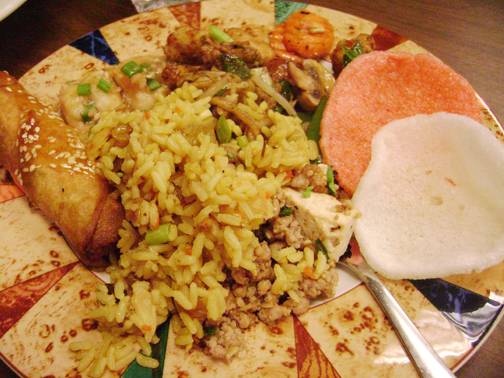
Stir-fried shrimp with lobster sauce. Lobster sauce has no lobster in it. It's basically a dressed up black bean sauce that was supposedly developed to be served with a lobster dish called Lobster Cantonese.

Beef lo mein--good stuff, if you're a lo mein fan
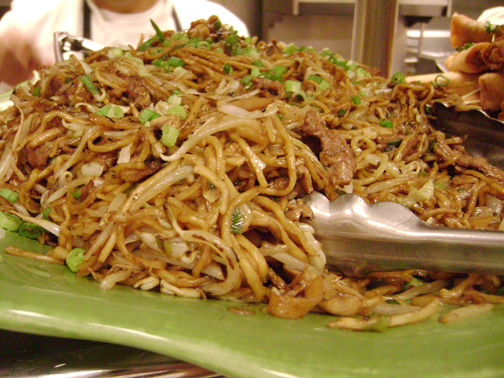
Egg rolls/spring rolls. I won't lie--I love wrapping spring rolls. When I was a kid, it was one of the first jobs my mom entrusted me with in the kitchen, and it was one of the kitchen chores I didn't (usually) run away from. I love the way these were plated. Nothing special--just some sprouts sprinkled around--but it looked so elegant. Much more elegant than my Lincoln Log Pyramids of Lumpia, anyway. ;D
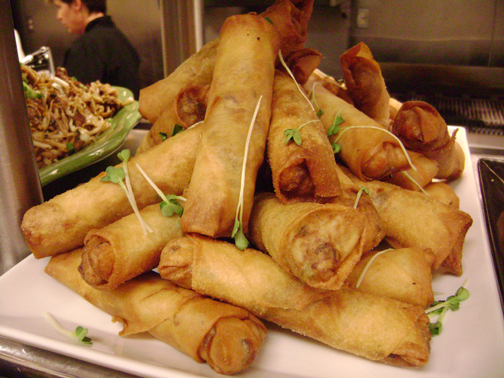
Curried pineapple rice. The golden raisins were a wonderful touch, and they looked so much nicer than the rat-poo-looking raisins the original recipe called for. I also think they have a mellower taste than black raisins.
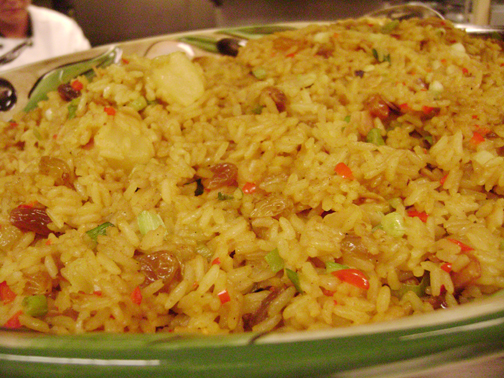
Hunan beef. Mmmm ... Each person in my group stir-fried this differently, but it all tasted the same. One followed the recipe closely, frying up the aromatics first, then adding the veggies, then removing the veggies to cook the beef, then adding the veggies, then the sauce. The next added the aromatics, then the beef, then took the beef out and cooked the veggies, then added the beef to the veggies, then sauced it. I first did my aromatics, then the beef til it was mostly cooked, then added the veggies, then the sauce (literally, a one-skillet meal). The next, who's always afraid of burning her garlic, ginger, and scallions, did the veggies first, then added the aromatics to them, took them out to cook the beef, then added the veggies, then sauced it.
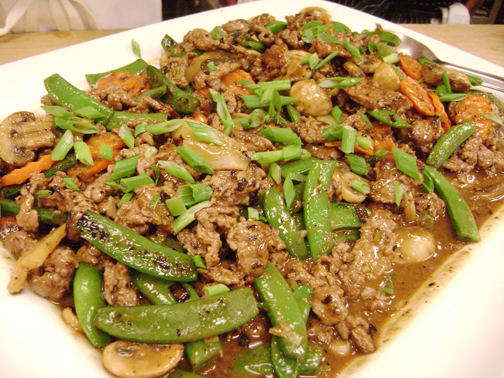
Mapo tofu. I was pleased to see that Chef had taken the Martin Yan recipe for this, which is the recipe I use when I make mapo tofu. I usually slice the tofu into much smaller cubes, but I think the intent was to make the tofu easy to remove for those who don't enjoy it. We use so many chives as garnish, I think I eat a full serving of veggies just from chive garnish alone.
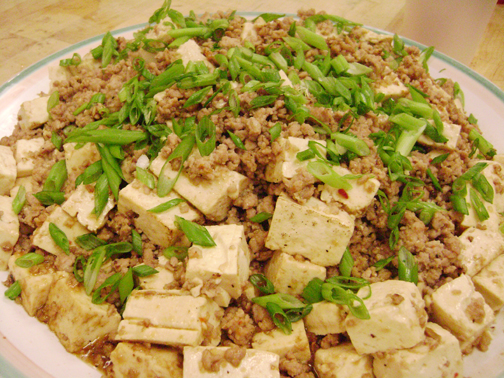
Orange chicken. Again with the double fry technique. After I took the picture, we stuffed some nicely sliced orange pieces all over to finish the plating. Chef was very cautious about reminding us not to be like certain chain Chinese joints that add more orange peel than chicken to the dish.
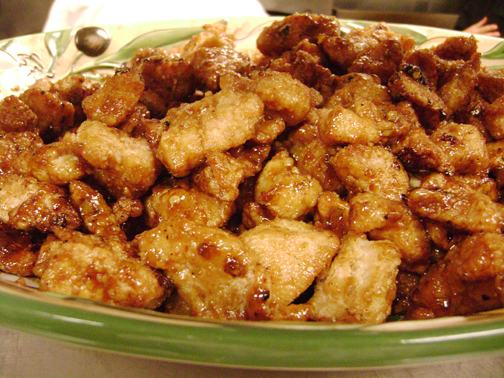
Notes:
*There's nothing as invigorating as cooking with upwards of 90,000-120,000 BTUs. My kitchen science may be a little shaky here--I did really poorly with that part of science that had to do with energy. So, in my bumbling way: A BTU is a British Thermal Unit. A single BTU will heat one pound of water 1 degree Fahrenheit. If you placed a pound of water, or 2 cups, at 78 degrees on heat, you would need to raise its temperature 134 degrees, to 212F, to get it to boil. Since it needs to go up 134 degrees, you'd need 134 BTUs to do it. A higher BTU heating element will do the job more quickly. The average commercial range delivers 15,000-32,000 BTUs. Home stoves seem to cap out at 20,000 BTUs and below, with some manufacturers calling 11,000 BTUs the high-output burner.
Velveted chicken is often blanched, while meat (beef, lamb, whatever) is not--it's just tossed into the stir-fry. As noted above in the Hunan Beef section, there doesn't seem to be a better way to cook meat and veg stir-frys when considering what order in which to cook things. I knew we were in a hurry, and that's why I tried to take the most straightforward route.
Shrimp chips are awesome, but maybe I think that only because I grew up eating them. They're like shrimp-flavored cheet-os, only without the annoying orange goop that ends up stuck to your fingers. Chef told us he thought that more restaurants didn't use them because they seemed low class. I don't care. I'm glad he brought them and reminded me of their existence. They look so much like styrofoam, it's scary. And when you hold one between your lips, it makes your lips tingle as if all the little air pockets made when frying them are sort of gently closing against your lips. I know, weird, but I dig it. Plus, they come in more colors than Mardi Gras! Chef intended them to be a garnish for the shrimp with lobster sauce, but we just ended up eating them on the side for dessert.
I forgot to photograph the Soft Tofu and Spinach Soup! But I'll make a note about tofu. If you drain it before using it, it will better absorb the flavor of your dish's sauce and main ingredients. Of course, it's easier to drain firm tofu: rest the whole block on a cutting board, incline the cutting board so it can drain into the sink, and put something like a stack of plates or another cutting board with cans sitting on it to apply a firm and steady pressure to the tofu. After about 30 minutes, you can slice your tofu up and add it to your dish just at the end of cooking, long enough for it to soak up the flavor, but not so long that you turn its soft, silky texture into something that can become almost unpleasantly firm (thought that firmness doesn't really bother me).
One of my teammate's plates, clockwise from spring roll: beef lo mein, shrimp chip, orange chicken, ma po tofu, stir-fried shrimp with lobster sauce, curried pineapple rice, Hunan beef

My plate, clockwise from shrimp chips: ma po tofu, curried pineapple rice, spring roll, stir-fried shrimp with lobster sauce, Hunan beef, and some beef lo mein buried in the middle.My deep, dark secret: I always cringe when I pay for my culinary classes. Even though it's at a community college, they're still not cheap (for me) at $245. So, it's a nice bonus that we get to take the leftovers home. I brought home enough leftovers for four meals this week, and it was pretty much the same last week. Woot!

Stir-fried shrimp with lobster sauce. Lobster sauce has no lobster in it. It's basically a dressed up black bean sauce that was supposedly developed to be served with a lobster dish called Lobster Cantonese.

Beef lo mein--good stuff, if you're a lo mein fan

Egg rolls/spring rolls. I won't lie--I love wrapping spring rolls. When I was a kid, it was one of the first jobs my mom entrusted me with in the kitchen, and it was one of the kitchen chores I didn't (usually) run away from. I love the way these were plated. Nothing special--just some sprouts sprinkled around--but it looked so elegant. Much more elegant than my Lincoln Log Pyramids of Lumpia, anyway. ;D

Curried pineapple rice. The golden raisins were a wonderful touch, and they looked so much nicer than the rat-poo-looking raisins the original recipe called for. I also think they have a mellower taste than black raisins.

Hunan beef. Mmmm ... Each person in my group stir-fried this differently, but it all tasted the same. One followed the recipe closely, frying up the aromatics first, then adding the veggies, then removing the veggies to cook the beef, then adding the veggies, then the sauce. The next added the aromatics, then the beef, then took the beef out and cooked the veggies, then added the beef to the veggies, then sauced it. I first did my aromatics, then the beef til it was mostly cooked, then added the veggies, then the sauce (literally, a one-skillet meal). The next, who's always afraid of burning her garlic, ginger, and scallions, did the veggies first, then added the aromatics to them, took them out to cook the beef, then added the veggies, then sauced it.

Mapo tofu. I was pleased to see that Chef had taken the Martin Yan recipe for this, which is the recipe I use when I make mapo tofu. I usually slice the tofu into much smaller cubes, but I think the intent was to make the tofu easy to remove for those who don't enjoy it. We use so many chives as garnish, I think I eat a full serving of veggies just from chive garnish alone.

Orange chicken. Again with the double fry technique. After I took the picture, we stuffed some nicely sliced orange pieces all over to finish the plating. Chef was very cautious about reminding us not to be like certain chain Chinese joints that add more orange peel than chicken to the dish.

Notes:
*There's nothing as invigorating as cooking with upwards of 90,000-120,000 BTUs. My kitchen science may be a little shaky here--I did really poorly with that part of science that had to do with energy. So, in my bumbling way: A BTU is a British Thermal Unit. A single BTU will heat one pound of water 1 degree Fahrenheit. If you placed a pound of water, or 2 cups, at 78 degrees on heat, you would need to raise its temperature 134 degrees, to 212F, to get it to boil. Since it needs to go up 134 degrees, you'd need 134 BTUs to do it. A higher BTU heating element will do the job more quickly. The average commercial range delivers 15,000-32,000 BTUs. Home stoves seem to cap out at 20,000 BTUs and below, with some manufacturers calling 11,000 BTUs the high-output burner.
Velveted chicken is often blanched, while meat (beef, lamb, whatever) is not--it's just tossed into the stir-fry. As noted above in the Hunan Beef section, there doesn't seem to be a better way to cook meat and veg stir-frys when considering what order in which to cook things. I knew we were in a hurry, and that's why I tried to take the most straightforward route.
Shrimp chips are awesome, but maybe I think that only because I grew up eating them. They're like shrimp-flavored cheet-os, only without the annoying orange goop that ends up stuck to your fingers. Chef told us he thought that more restaurants didn't use them because they seemed low class. I don't care. I'm glad he brought them and reminded me of their existence. They look so much like styrofoam, it's scary. And when you hold one between your lips, it makes your lips tingle as if all the little air pockets made when frying them are sort of gently closing against your lips. I know, weird, but I dig it. Plus, they come in more colors than Mardi Gras! Chef intended them to be a garnish for the shrimp with lobster sauce, but we just ended up eating them on the side for dessert.
I forgot to photograph the Soft Tofu and Spinach Soup! But I'll make a note about tofu. If you drain it before using it, it will better absorb the flavor of your dish's sauce and main ingredients. Of course, it's easier to drain firm tofu: rest the whole block on a cutting board, incline the cutting board so it can drain into the sink, and put something like a stack of plates or another cutting board with cans sitting on it to apply a firm and steady pressure to the tofu. After about 30 minutes, you can slice your tofu up and add it to your dish just at the end of cooking, long enough for it to soak up the flavor, but not so long that you turn its soft, silky texture into something that can become almost unpleasantly firm (thought that firmness doesn't really bother me).
Comments
My new thing, diet-wise, are AB's granola bars, from the power bar episode of Good Eats. A little on the sweet side, but good for breakfast with a mug of coffee.